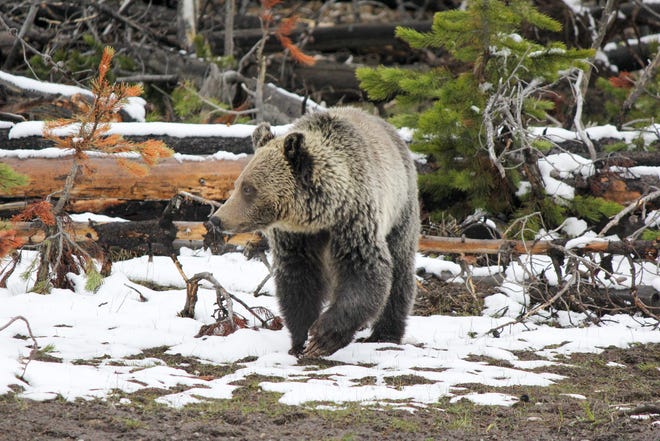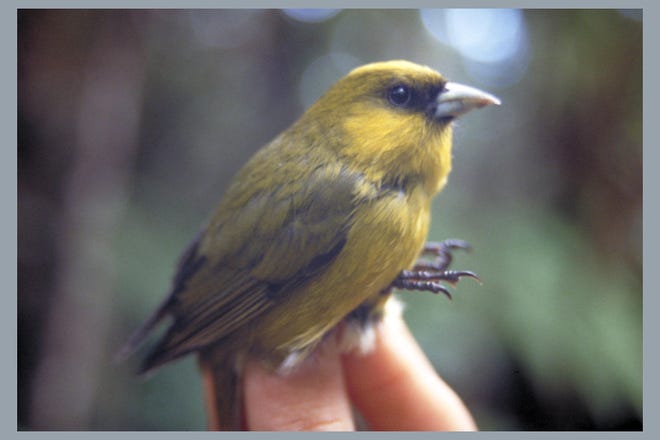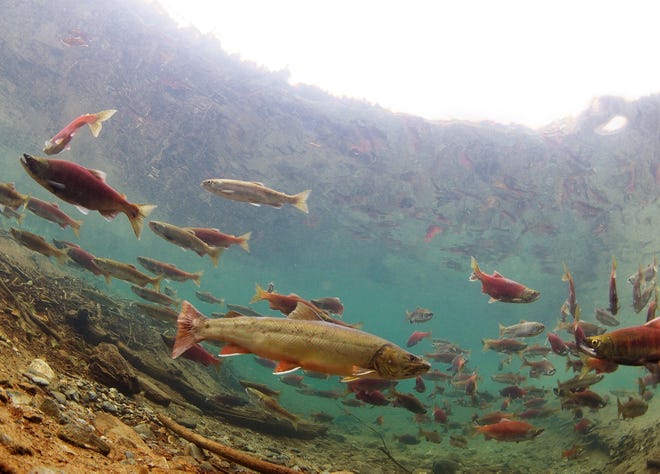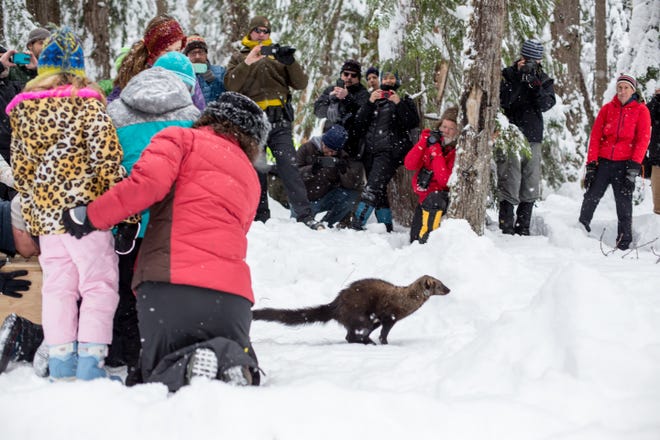Some states hope to move climate-threatened species, but others say no way

North Carolina might need to move a snail.
A tiny mollusk known as the magnificent ramshorn has long made its home in the state’s freshwater coastal ponds. But sea level rise and storm surges are making those ponds saltier, and the snail can’t tolerate salt. The coastal plain that was once the species’ habitat has no snails left — the only surviving members are bred in captivity.
If the magnificent ramshorn is to flourish in the wild again, it may well have to be somewhere new.
“There are very few places that exist in its known historic range that would still be suitable for it to live,” said Kyle Briggs, chief deputy director of the North Carolina Wildlife Resources Commission.
The ramshorn is one of many species that are finding their long-established habitats increasingly inhospitable because of warmer temperatures, rising oceans, wildfires and droughts brought on by climate change.
Some wildlife officials want to help those plants and animals find new homes, a tactic known as assisted migration. In the coming weeks, the U.S. Fish and Wildlife Service is expected to issue a final rule that could allow wildlife managers to introduce endangered species in habitats where they’ve never been seen before.
“It just allows us to have more flexibility when that is needed,” said Elizabeth Maclin, division chief for restoration and recovery with the U.S. Fish and Wildlife Service. “When a habitat has been depleted to the extent that it’s no longer suitable for a species, we’re able to have the tools we need to prevent its extinction.
States such as North Carolina have been following the proposal closely since the agency released it a year ago. They see the threats climate change poses, and many acknowledge that some species won’t survive without help getting to new places.
But state wildlife officials disagree about whether the feds’ plan is a good idea. In Michigan, wildlife managers hope the change will allow them to move a tiny blue butterfly northward. Arizona officials, however, fear that relocating a wolf to a new habitat could unleash serious ecological risks.

Other states, including North Carolina, are willing to consider assisted migration but have deep concerns about how it will be carried out.
“This is a really big opportunity that I’d hate for us to miss, but I think it needs to be done correctly and with the concurrence of the states,” Briggs said.
North Carolina is among several states asking for a “concurrence” provision, essentially requiring state wildlife officials’ approval before the feds could move a species. The federal agency would not comment on whether it is considering those requests.
The states’ role
The U.S. Fish and Wildlife Service oversees management of endangered species including the magnificent ramshorn (for marine species, that role falls to the National Marine Fisheries Service). But state wildlife managers often work closely with the feds on plans to preserve and restore those populations, such as habitat restoration projects and landowner incentive programs.
And state agencies are responsible for keeping species without federal protection out of the “emergency room.” They’re fiercely protective of that role and wary of threats that could place a species under endangered status, removing it from the state’s purview and bringing along a host of federal regulations and restrictions.
The Association of Fish & Wildlife Agencies, a nonprofit advocacy group representing state wildlife managers, expressed “cautious support” for the federal proposal, said Lane Kisonak, the group’s chief legal officer. While member agencies have differing views on the rule, he said, they share a belief that any species relocation efforts should require extensive collaboration with the states.
“There’s a strong desire by the states to have that cooperation maximized,” he said.
In Hawaii, which has more endangered species than any other state, wildlife officials have welcomed the proposal. Two species of Hawaiian honeycreepers are among the forest birds that are particularly threatened as climate change brings invasive mosquitoes — and deadly avian malaria — into upper elevation forests.

“We’re the endangered species capital of the world, and our landscape has changed so much,” said Kathryn Stanaway, program specialist with the Division of Forestry and Wildlife in the state Department of Land and Natural Resources. “We want to establish populations outside of their historical range in some instances, and we can do that under state law, but we can’t do that under federal law the way it’s currently written.”
But some wildlife managers fear the assisted migration of federally protected species could prove harmful to other species under the states’ care. Wyoming officials have identified more than 800 species of “greatest conservation need,” which are not currently listed as endangered but may require state action to address declining populations.
“Our role is to keep those species common,” said Angela Bruce, deputy director of external affairs at the Wyoming Game and Fish Department. “Putting endangered species in non-historic ranges could throw off the ecological balance and throw off all the great work we’re trying to do. The risk is too high to jeopardize all the other species.”
Much of the Wyoming agency’s conservation work comes through voluntary partnerships with landowners, who are wary of the restrictions that often come along with endangered species status. Putting such species in new places would jeopardize those relationships, Bruce said.
While Wyoming sees the proposal as a threat to its own wildlife management efforts, others believe it could empower states. Doug Vincent-Lang, commissioner of the Alaska Department of Fish and Game, said the rule change could be the first step to one day allowing species to be moved before they’re listed as endangered. Such preemptive rescues also would keep those species from falling under federal authority.

“We see [assisted migration] as a means to move species around the landscape to prevent them from getting listed under the Endangered Species Act,” he said. “That would allow us to retain state management.”
Vincent-Lang mentioned wolverines as a candidate for relocation. If assisted migration were eventually allowed for state-managed species, Alaska officials could help wolverines migrate to more suitable areas before dwindling snowpack in their current range put them on the endangered species list.
The track record
Washington state has successfully reintroduced fishers, a small member of the weasel family that had been eradicated in the state because of trapping and habitat loss. While state wildlife officials support changing the rule to allow such relocations in new ranges, they caution that it won’t be an easy answer to habitat loss caused by climate change.
“Translocations are difficult, expensive, they don’t always succeed and there’s a lot of risks,” said Hannah Anderson, wildlife diversity division manager with the Washington Department of Fish and Wildlife. “I would perceive [assisted migration] as another tool in the toolbox, but it’s not like we would immediately jump to that.”
While the Washington agency supports the rule change, Native tribes that serve as co-managers of the state’s fisheries are skeptical.
“This would need to be done very carefully, in full consultation and collaboration with affected tribes, and we don’t see a track record that leads us to believe that that’s the way this would move forward,” said Rob Jones, fisheries policy analyst with the Northwest Indian Fisheries Commission, a coordinating body for treaty tribes in western Washington. “This is a half-baked idea without those specifics.”
At least a dozen states weighed in through comment letters sent to the federal agency. Wildlife officials in Oregon, Florida and Missouri all said species may need to be moved to new areas to save them from climate change, but urged the feds to craft strong safeguards that acknowledge the ecological risks of such maneuvers. Leaders in New Mexico and Montana opposed it altogether.

“To introduce experimental populations to new ecosystems renders the experimental population nothing more than an invasive species, threatening the natural balance within the ecosystem unaccustomed to its presence,” wrote Montana Gov. Greg Gianforte, a Republican.
Many states — both supporters and opponents of the rule — also expressed concern about social and economic consequences. Areas with endangered animals and plants can face severe limitations on development, ranching, mining and other land-use activities that could disrupt the species.
Federal officials say that past reintroductions of endangered species — in areas where they’d previously lived — show that the model can work. Such “experimental populations” can have more flexible rules that are often less restrictive, but some states still fear that adding endangered species to a landscape could have major economic consequences and public backlash for those regions.
Maclin, with the federal agency, said introductions of experimental populations account for the community impact. She pointed to the black-footed ferret, which has been reintroduced with allowances that permit landowners to manage their lands without fear they will inadvertently violate the Endangered Species Act.
While states weigh the ecological and economic repercussions of the proposal, many environmental advocates say it would be more costly not to act.
“This is an emergency room situation where species are going to blink out if we don’t help them,” said Elise Bennett, Florida director and senior attorney with the Center for Biological Diversity, an environmental advocacy group. “We would much prefer and urge preventative care, but within the policy framework of the Endangered Species Act, Congress was quite clear that we have to prevent extinction of a species — no matter what the cost is.”
Stateline is part of States Newsroom, a national nonprofit news organization focused on state policy.
No comments: